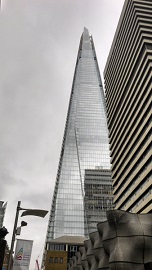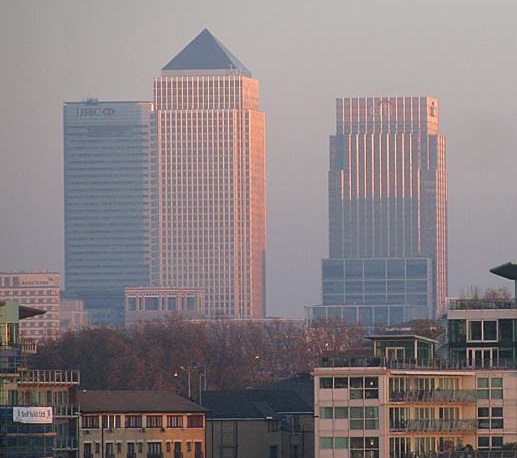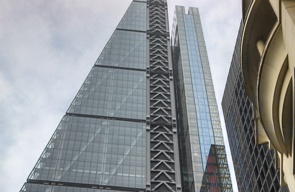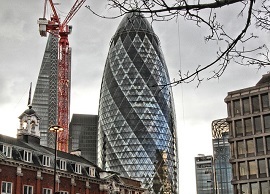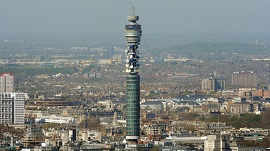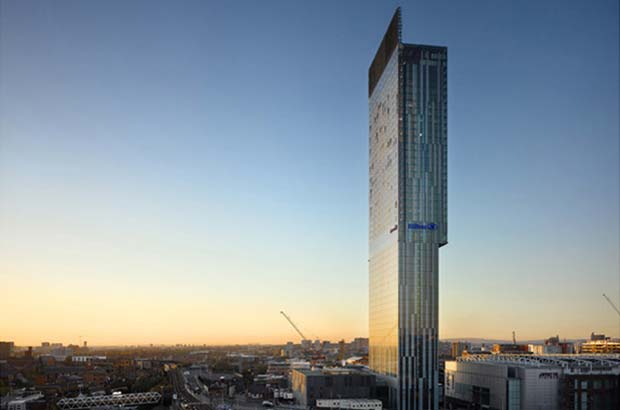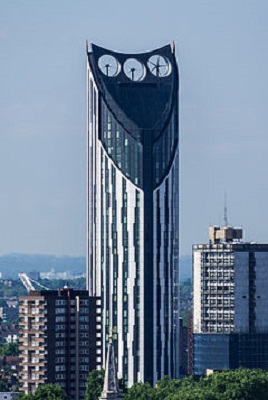Tallest buildings in the UK
[edit] Introduction
This list of the UK’s tallest buildings includes only those with continuously occupiable floors, as opposed to non-building structures such as communications towers. Roof or spire height is taken into consideration in this ranking, but not antenna height.
(This classification excludes Emley Moor transmitting station which, at a height of 330.4 m (1,084 ft), is the tallest freestanding structure in the UK.)
(Correct as of 23 November 2018.)
[edit] Top 20
1. The Shard, London. (2012), 309.6 m (1,016 ft).
Has held the title of the UK’s tallest building since 2012.
2. One Canada Square, London. (1991), 235 m (770 ft).
UK’s tallest building 1990 – 2012.
3. Heron Tower, London. (2010), 230 m (755 ft).
4. Leadenhall Building, London. (2014), 225 m (737 ft).
5. Deansgate Square – South Tower, Manchester. (Under construction) expected to be 201 m (659 ft).
6. 8 Canada Square, London. (2002), 200 m (656 ft), and 25 Canada Square, London (2001), 200 m (656 ft).
7. NatWest Tower, London. (1980), 183 m (600 ft).
UK’s tallest building 1980 – 1990.
8. St. George Wharf Tower, London. (2014), 181 m (594 ft).
9. 30 St. Mary Axe – ‘The Gherkin’, London. (2003), 180 m (591 ft).
10. BT Tower, London. (1964), 177 m (581 ft).
UK’s tallest building 1964 – 1980.
11. Beetham Tower, Manchester. (2006), 169 m (554 ft).
12. Broadgate Tower, London. (2008), 161 m (528 ft).
13. 20 Fenchurch Street – ‘The Walkie-Talkie’, London. (2014), 160 m (525 ft).
14. One Churchill Place, London. (2004), 156 m (512 ft).
15. 25 Bank Street, London. (2003), 153 m (502 ft), and 40 Bank Street, London. (2003), 153 m (502 ft).
16. 10 Upper Bank Street, London. (2003), 151 m (495 ft), and South Bank Tower, London. (2015), 151 m (495 ft).
17. Arena Tower, London. (2016), 150 m (490 ft).
18. Highpoint, London. (2018), 149 m (487 ft).
19. Strata SE1, London. (2010), 148 m (486 ft).
20. Pan Peninsula East Tower, London. (2008), 147 m (484 ft)
Before the completion of the BT Tower in 1964, the tallest buildings in the UK had been:
- Millbank Tower, London. (1963 – 1964), 118 m (387 ft).
- CIS Tower, Manchester. (1962 – 1964), 118m (387 ft).
- Shell Centre, London. (1961 – 1962), 107 m (351 ft).
- Royal Liver Building, Liverpool. (1911 – 1961), 50.9 m (167 ft).
[edit] Related articles on Designing Buildings Wiki
Featured articles and news
Latest Build UK Building Safety Regime explainer published
Key elements in one short, now updated document.
UKGBC launch the UK Climate Resilience Roadmap
First guidance of its kind on direct climate impacts for the built environment and how it can adapt.
CLC Health, Safety and Wellbeing Strategy 2025
Launched by the Minister for Industry to look at fatalities on site, improving mental health and other issues.
One of the most impressive Victorian architects. Book review.
Common Assessment Standard now with building safety
New CAS update now includes mandatory building safety questions.
RTPI leader to become new CIOB Chief Executive Officer
Dr Victoria Hills MRTPI, FICE to take over after Caroline Gumble’s departure.
Social and affordable housing, a long term plan for delivery
The “Delivering a Decade of Renewal for Social and Affordable Housing” strategy sets out future path.
A change to adoptive architecture
Effects of global weather warming on architectural detailing, material choice and human interaction.
The proposed publicly owned and backed subsidiary of Homes England, to facilitate new homes.
How big is the problem and what can we do to mitigate the effects?
Overheating guidance and tools for building designers
A number of cool guides to help with the heat.
The UK's Modern Industrial Strategy: A 10 year plan
Previous consultation criticism, current key elements and general support with some persisting reservations.
Building Safety Regulator reforms
New roles, new staff and a new fast track service pave the way for a single construction regulator.
Architectural Technologist CPDs and Communications
CIAT CPD… and how you can do it!
Cooling centres and cool spaces
Managing extreme heat in cities by directing the public to places for heat stress relief and water sources.
Winter gardens: A brief history and warm variations
Extending the season with glass in different forms and terms.
Restoring Great Yarmouth's Winter Gardens
Transforming one of the least sustainable constructions imaginable.






